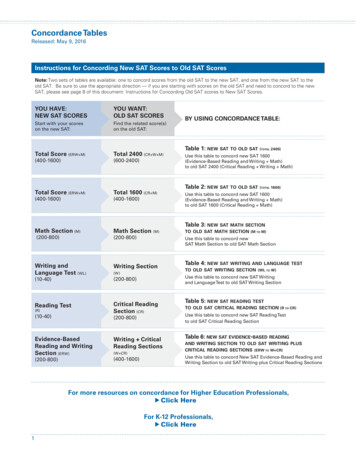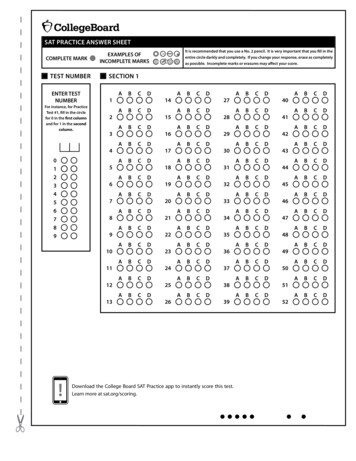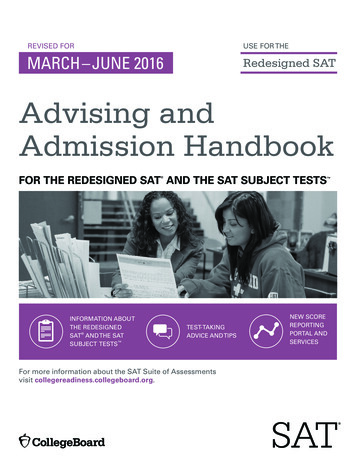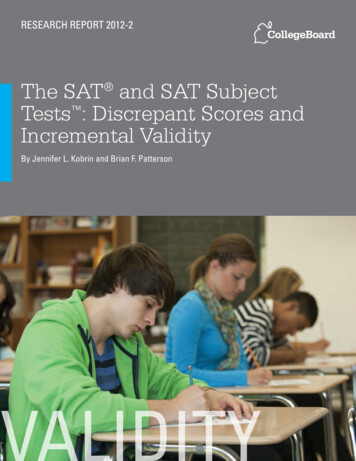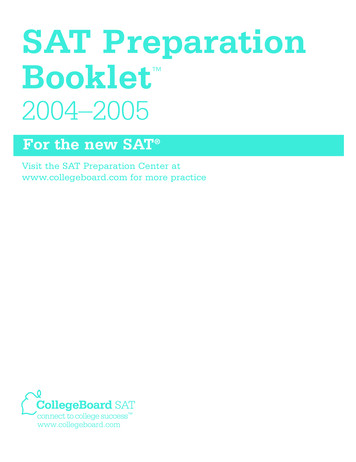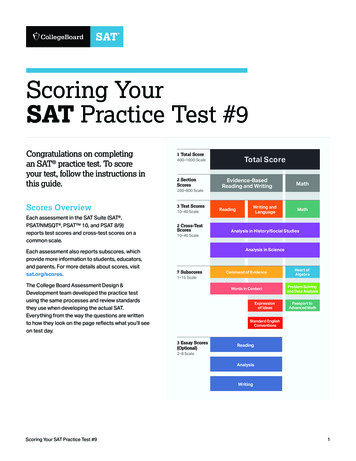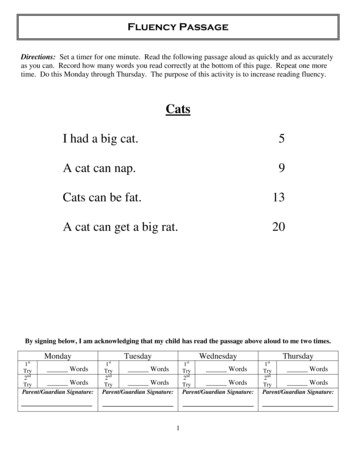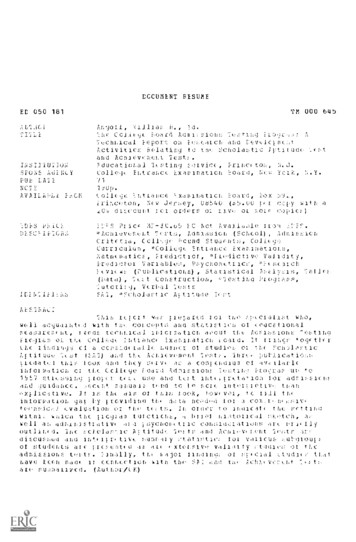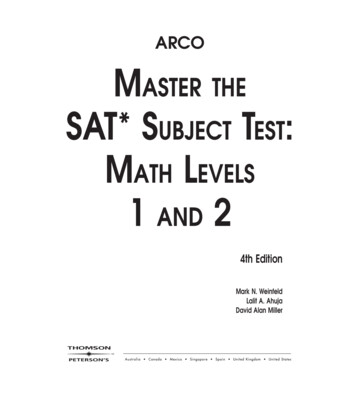
Transcription
ARCOMASTER THESAT* SUBJECT TEST:MATH LEVELS1 AND 24th EditionMark N. WeinfeldLalit A. AhujaDavid Alan Miller
An ARCO BookARCO is a registered trademark of Thomson Learning, Inc., and is used herein under licenseby Thomson Peterson’s.About Thomson Peterson’sThomson Peterson’s (www.petersons.com) is a leading provider of education information and advice, with books andonline resources focusing on education search, test preparation, and financial aid. Its Web site offers searchabledatabases and interactive tools for contacting educational institutions, online practice tests and instruction, and planningtools for securing financial aid. Thomson Peterson’s serves 110 million education consumers annually.For more information, contact Thomson Peterson’s, 2000 Lenox Drive, Lawrenceville, NJ 08648;800-338-3282; or find us on the World Wide Web at www.petersons.com/about. 2006 Thomson Peterson’s, a part of The Thomson CorporationThomson Learning is a trademark used herein under license.Previous editions published as SAT II Success Math 1C and IIC 2000, 2001, 2004Special thanks to Joan Marie RosebushEditor: Wallie Walker Hammond; Production Editor: Alysha Bullock; ManufacturingManager: Raymond Golaszewski; Composition Manager: Gary RozmierskiALL RIGHTS RESERVED. No part of this work covered by the copyright herein may bereproduced or used in any form or by any means—graphic, electronic, or mechanical,including photocopying, recording, taping, Web distribution, or information storage andretrieval systems—without the prior written permission of the publisher.For permission to use material from this text or product, submit a request online atwww.thomsonrights.comAny additional questions about permissions can be submitted by e-mail tothomsonrights@thomson.comISBN 13: 978-0-7689-2304-9ISBN 10: 0-7689-2304-2Printed in the United States of America10987Fourth Edition65432 108 07 06
Contents.Before You Begin . . . . . . . . . . . . . . . . . . . . . . . . . . . . . . . . . viiHow This Book Is Organized . . . . . . . . . . . . . . . . . . . . . . . . . . viiComprehensive Answer Explanations . . . . . . . . . . . . . . . . . . . viiiSpecial Study Features . . . . . . . . . . . . . . . . . . . . . . . . . . . . . . . . viiiYou’re Well on Your Way to Success . . . . . . . . . . . . . . . . . . . ixTop 10 Ways to Raise Your Score . . . . . . . . . . . . . . . . . . . . . .xPART I: SAT SUBJECT TEST BASICS1All About the SAT Subject Test: Math Levels 1and 2 . . . . . . . . . . . . . . . . . . . . . . . . . . . . . . . . . . . . . . . . . . . . .Get to Know the Exam Format . . . . . . . . . . . . . . . . . . . . . . . . .When to Use Calculators . . . . . . . . . . . . . . . . . . . . . . . . . . . . . .How the Test Is Scored . . . . . . . . . . . . . . . . . . . . . . . . . . . . . . .Some Test-wise Strategies for SAT Subject Test Success . . . .Educated Guessing Will Boost Your Score! . . . . . . . . . . . . . . .Getting Ready: The Night Before and the Day of the Test . .Summing It Up . . . . . . . . . . . . . . . . . . . . . . . . . . . . . . . . . . . . . .33444668PART II: DIAGNOSING STRENGTHS ANDWEAKNESSES2Practice Test 1: Diagnostic Level 1 . . . . . . . . . . . . . . . . . 11Preparing to Take the Diagnostic Test . . . . . . . . . . . . . . . . . . .Practice Test 1: Diagnostic Level 1. . . . . . . . . . . . . . . . . . . . . .Reference Information . . . . . . . . . . . . . . . . . . . . . . . . . . . . . . . .Answer Key and Explanations . . . . . . . . . . . . . . . . . . . . . . . . .311111221Practice Test 2: Diagnostic Level 2 . . . . . . . . . . . . . . . . . 25Preparing to Take the Diagnostic Test . . . . . . . . . . . . . . . . . . . 25Practice Test 2: Diagnostic Level 2. . . . . . . . . . . . . . . . . . . . . . 25Reference Information . . . . . . . . . . . . . . . . . . . . . . . . . . . . . . . . 26Answer Key and Explanations . . . . . . . . . . . . . . . . . . . . . . . . . 35iii
ivContents.PART III: SAT SUBJECT TEST: MATH REVIEW4Multiple-Choice Math Strategies . . . . . . . . . . . . . . . . . . . . . . . . . . . . . . 43Solving Multiple-choice Math Questions . . . . . . . . . . . . . . . . . . . . . . . . . . . . . 43Know When to Use Your Calculator . . . . . . . . . . . . . . . . . . . . . . . . . . . . . . . . 45Learn the Most Important Multiple-choice Math Tips . . . . . . . . . . . . . . . . . . 45Summing It Up . . . . . . . . . . . . . . . . . . . . . . . . . . . . . . . . . . . . . . . . . . . . . . . . . . 595Numbers and Operations Review. . . . . . . . . . . . . . . . . . . . . . . . . . . . .Properties of Numbers . . . . . . . . . . . . . . . . . . . . . . . . . . . . . . . . . . . . . . . . . . . .Exercise: Properties of Numbers. . . . . . . . . . . . . . . . . . . . . . . . . . . . . . . .Answers and Explanations . . . . . . . . . . . . . . . . . . . . . . . . . . . . . . . . . . . . .Whole Numbers . . . . . . . . . . . . . . . . . . . . . . . . . . . . . . . . . . . . . . . . . . . . . . . . .Operations with Whole Numbers . . . . . . . . . . . . . . . . . . . . . . . . . . . . . . . . . . .Exercise: Whole Numbers . . . . . . . . . . . . . . . . . . . . . . . . . . . . . . . . . . . . .Answers and Explanations . . . . . . . . . . . . . . . . . . . . . . . . . . . . . . . . . . . . .Operations with Fractions . . . . . . . . . . . . . . . . . . . . . . . . . . . . . . . . . . . . . . . . .Exercise: Fractions . . . . . . . . . . . . . . . . . . . . . . . . . . . . . . . . . . . . . . . . . . .Answers and Explanations . . . . . . . . . . . . . . . . . . . . . . . . . . . . . . . . . . . . .Operations with Decimals . . . . . . . . . . . . . . . . . . . . . . . . . . . . . . . . . . . . . . . . .Decimals and Fractions. . . . . . . . . . . . . . . . . . . . . . . . . . . . . . . . . . . . . . . . . . . .Exercise: Decimals and Fractions . . . . . . . . . . . . . . . . . . . . . . . . . . . . . . .Answers and Explanations . . . . . . . . . . . . . . . . . . . . . . . . . . . . . . . . . . . . .Operations with Percents . . . . . . . . . . . . . . . . . . . . . . . . . . . . . . . . . . . . . . . . .Exercise: Percents . . . . . . . . . . . . . . . . . . . . . . . . . . . . . . . . . . . . . . . . . . . .Answers and Explanations . . . . . . . . . . . . . . . . . . . . . . . . . . . . . . . . . . . . .Exercise: Percent Word Problems. . . . . . . . . . . . . . . . . . . . . . . . . . . . . . .Answers and Explanations . . . . . . . . . . . . . . . . . . . . . . . . . . . . . . . . . . . . .Systems of Measurements . . . . . . . . . . . . . . . . . . . . . . . . . . . . . . . . . . . . . . . . .Exercise: Systems of Measurement . . . . . . . . . . . . . . . . . . . . . . . . . . . . . .Answers and Explanations . . . . . . . . . . . . . . . . . . . . . . . . . . . . . . . . . . . . .Signed Numbers . . . . . . . . . . . . . . . . . . . . . . . . . . . . . . . . . . . . . . . . . . . . . . . . .Exercise: Signed Numbers . . . . . . . . . . . . . . . . . . . . . . . . . . . . . . . . . . . . .Answers and Explanations . . . . . . . . . . . . . . . . . . . . . . . . . . . . . . . . . . . . .Summing It Up . . . . . . . . . . . . . . . . . . . . . . . . . . . . . . . . . . . . . . . . . . . . . . . . . .6Algebra and Functions Review . . . . . . . . . . . . . . . . . . . . . . . . . . . . . . . . 111Powers, Exponents, and Roots . . . . . . . . . . . . . . . . . . . . . . . . . . . . . . . . . . . . .Exercise: Exponents, Powers, and Roots . . . . . . . . . . . . . . . . . . . . . . . . .Answers and Explanations . . . . . . . . . . . . . . . . . . . . . . . . . . . . . . . . . . . . .Algebra . . . . . . . . . . . . . . . . . . . . . . . . . . . . . . . . . . . . . . . . . . . . . . . . . . . . . . . . .Exercise: Algebra. . . . . . . . . . . . . . . . . . . . . . . . . . . . . . . . . . . . . . . . . . . . .Answers and Explanations . . . . . . . . . . . . . . . . . . . . . . . . . . . . . . . . . . . . .Exercise: Equations . . . . . . . . . . . . . . . . . . . . . . . . . . . . . . . . . . . . . . . . . . .Answers and Explanations . . . . . . . . . . . . . . . . . . . . . . . . . . . . . . . . . . . . 132
Contentsv.7Geometry and Measurement Review . . . . . . . . . . . . . . . . . . . . . . . . . 177Plane Geometry . . . . . . . . . . . . . . . . . . . . . . . . . . . . . . . . . . . . . . . . . . . . . . . . . .Three-dimensional Geometry. . . . . . . . . . . . . . . . . . . . . . . . . . . . . . . . . . . . . . .Exercise: Geometry. . . . . . . . . . . . . . . . . . . . . . . . . . . . . . . . . . . . . . . . . . .Answers and Explanations . . . . . . . . . . . . . . . . . . . . . . . . . . . . . . . . . . . . .Coordinate Geometry . . . . . . . . . . . . . . . . . . . . . . . . . . . . . . . . . . . . . . . . . . . . .Exercise: Coordinate Geometry. . . . . . . . . . . . . . . . . . . . . . . . . . . . . . . . .Answers and Explanations . . . . . . . . . . . . . . . . . . . . . . . . . . . . . . . . . . . . .Trigonometry . . . . . . . . . . . . . . . . . . . . . . . . . . . . . . . . . . . . . . . . . . . . . . . . . . . .Exercise: Trigonometry . . . . . . . . . . . . . . . . . . . . . . . . . . . . . . . . . . . . . . .Answers and Explanations . . . . . . . . . . . . . . . . . . . . . . . . . . . . . . . . . . . . .Trigonometric Functions of the General Angle. . . . . . . . . . . . . . . . . . . . . . . .Exercise: Trigonometric Functions . . . . . . . . . . . . . . . . . . . . . . . . . . . . . .Answers and Explanations . . . . . . . . . . . . . . . . . . . . . . . . . . . . . . . . . . . . .Exercise: Trigonometric Identity and Equations . . . . . . . . . . . . . . . . . . .Answers and Explanations . . . . . . . . . . . . . . . . . . . . . . . . . . . . . . . . . . . . .Solving Triangles . . . . . . . . . . . . . . . . . . . . . . . . . . . . . . . . . . . . . . . . . . . . . . . . .Scalars and Vectors . . . . . . . . . . . . . . . . . . . . . . . . . . . . . . . . . . . . . . . . . . . . . . .Exercise: Triangles . . . . . . . . . . . . . . . . . . . . . . . . . . . . . . . . . . . . . . . . . . .Answers and Explanations . . . . . . . . . . . . . . . . . . . . . . . . . . . . . . . . . . . . .Graphs of Trigonometric Functions . . . . . . . . . . . . . . . . . . . . . . . . . . . . . . . . .Exercise: Graphs of the Trigonometric Functions . . . . . . . . . . . . . . . . .Answers and Explanations . . . . . . . . . . . . . . . . . . . . . . . . . . . . . . . . . . . . .Summing It Up . . . . . . . . . . . . . . . . . . . . . . . . . . . . . . . . . . . . . . . . . . . . . . . . . 8Data Analysis, Statistics, Probability, and AdvancedMath Review . . . . . . . . . . . . . . . . . . . . . . . . . . . . . . . . . . . . . . . . . . . . . . . . . . 259Set Theory . . . . . . . . . . . . . . . . . . . . . . . . . . . . . . . . . . . . . . . . . . . . . . . . . . . . . . 259Exercise: Sets . . . . . . . . . . . . . . . . . . . . . . . . . . . . . . . . . . . . . . . . . . . . . . . . 262Answers and Explanations . . . . . . . . . . . . . . . . . . . . . . . . . . . . . . . . . . . . . 263Probability . . . . . . . . . . . . . . . . . . . . . . . . . . . . . . . . . . . . . . . . . . . . . . . . . . . . . . 264Exercise: Probability . . . . . . . . . . . . . . . . . . . . . . . . . . . . . . . . . . . . . . . . . . 267Answers and Explanations . . . . . . . . . . . . . . . . . . . . . . . . . . . . . . . . . . . . . 268www.petersons.com.Exercise: Word Problems Involving One Unknown . . . . . . . . . . . . . . . .Answers and Explanations . . . . . . . . . . . . . . . . . . . . . . . . . . . . . . . . . . . . .Exercise: Equation-Solving . . . . . . . . . . . . . . . . . . . . . . . . . . . . . . . . . . . .Answers and Explanations . . . . . . . . . . . . . . . . . . . . . . . . . . . . . . . . . . . . .Exercise: Linear Inequalities and Equations. . . . . . . . . . . . . . . . . . . . . . .Answers and Explanations . . . . . . . . . . . . . . . . . . . . . . . . . . . . . . . . . . . . .Functions and Their Graphs . . . . . . . . . . . . . . . . . . . . . . . . . . . . . . . . . . . . . . .Exercise: Functions . . . . . . . . . . . . . . . . . . . . . . . . . . . . . . . . . . . . . . . . . . .Answers and Explanations . . . . . . . . . . . . . . . . . . . . . . . . . . . . . . . . . . . . .Summing It Up . . . . . . . . . . . . . . . . . . . . . . . . . . . . . . . . . . . . . . . . . . . . . . . . . .
viContents.Permutations and Combinations . . . . . . . . . . . . . . . . . . . . . . . . . . . . . . . . . . . .Exercise: Permutations and Combinations. . . . . . . . . . . . . . . . . . . . . . . .Answers and Explanations . . . . . . . . . . . . . . . . . . . . . . . . . . . . . . . . . . . . .Statistics . . . . . . . . . . . . . . . . . . . . . . . . . . . . . . . . . . . . . . . . . . . . . . . . . . . . . . . .Exercise: Statistics . . . . . . . . . . . . . . . . . . . . . . . . . . . . . . . . . . . . . . . . . . . .Answers and Explanations . . . . . . . . . . . . . . . . . . . . . . . . . . . . . . . . . . . . .Exponents and Logarithms. . . . . . . . . . . . . . . . . . . . . . . . . . . . . . . . . . . . . . . . .Exercise: Exponents and Logarithms . . . . . . . . . . . . . . . . . . . . . . . . . . . .Answers and Explanations . . . . . . . . . . . . . . . . . . . . . . . . . . . . . . . . . . . . .Logic . . . . . . . . . . . . . . . . . . . . . . . . . . . . . . . . . . . . . . . . . . . . . . . . . . . . . . . . . . .Exercise: Logic. . . . . . . . . . . . . . . . . . . . . . . . . . . . . . . . . . . . . . . . . . . . . . .Answers and Explanations . . . . . . . . . . . . . . . . . . . . . . . . . . . . . . . . . . . . .Systems of Numbers . . . . . . . . . . . . . . . . . . . . . . . . . . . . . . . . . . . . . . . . . . . . . .Exercise: Systems of Numbers. . . . . . . . . . . . . . . . . . . . . . . . . . . . . . . . . .Answers and Explanations . . . . . . . . . . . . . . . . . . . . . . . . . . . . . . . . . . . . .Complex Numbers . . . . . . . . . . . . . . . . . . . . . . . . . . . . . . . . . . . . . . . . . . . . . . .Exercise: Complex Numbers . . . . . . . . . . . . . . . . . . . . . . . . . . . . . . . . . . .Answers and Explanations . . . . . . . . . . . . . . . . . . . . . . . . . . . . . . . . . . . . .Sequences. . . . . . . . . . . . . . . . . . . . . . . . . . . . . . . . . . . . . . . . . . . . . . . . . . . . . . .Exercise: Sequences . . . . . . . . . . . . . . . . . . . . . . . . . . . . . . . . . . . . . . . . . .Answers and Explanations . . . . . . . . . . . . . . . . . . . . . . . . . . . . . . . . . . . . .Summing It Up . . . . . . . . . . . . . . . . . . . . . . . . . . . . . . . . . . . . . . . . . . . . . . . . . 04305306310311313PART IV: FOUR PRACTICE TESTSPractice Test 3: Level 1 . . . . . . . . . . . . . . . . . . . . . . . . . . . . . . . . . . . . . . . . 317Reference Information . . . . . . . . . . . . . . . . . . . . . . . . . . . . . . . . . . . . . . . . . . . . 318Answer Key and Explanations . . . . . . . . . . . . . . . . . . . . . . . . . . . . . . . . . . . . . 329Practice Test 4: Level 1 . . . . . . . . . . . . . . . . . . . . . . . . . . . . . . . . . . . . . . . . 339Reference Information . . . . . . . . . . . . . . . . . . . . . . . . . . . . . . . . . . . . . . . . . . . . 340Answer Key and Explanations . . . . . . . . . . . . . . . . . . . . . . . . . . . . . . . . . . . . . 351Practice Test 5: Level 2 . . . . . . . . . . . . . . . . . . . . . . . . . . . . . . . . . . . . . . . . 357Reference Information . . . . . . . . . . . . . . . . . . . . . . . . . . . . . . . . . . . . . . . . . . . . 358Answer Key and Explanations . . . . . . . . . . . . . . . . . . . . . . . . . . . . . . . . . . . . . 369Practice Test 6: Level 2 . . . . . . . . . . . . . . . . . . . . . . . . . . . . . . . . . . . . . . . . 377Reference Information . . . . . . . . . . . . . . . . . . . . . . . . . . . . . . . . . . . . . . . . . . . . 378Answer Key and Explanations . . . . . . . . . . . . . . . . . . . . . . . . . . . . . . . . . . . . . 388www.petersons.com
Before You Begin.HOW THIS BOOK IS ORGANIZEDAlmost a quarter of a million students take SAT Subject Tests every year. Inthe past, these tests were known as the College Board Achievement Tests.These tests are important for several reasons. Because many of the collegesrequire SAT Subject Tests, these are important exams for you. The purpose ofthese tests is to measure and demonstrate your knowledge and/or skills inspecific subjects and to test your ability to apply that knowledge to eachparticular examination. The better your score is, the better your applicationwill look to the colleges of your choice.If you’re reading this book, it’s likely that you are preparing for the SATSubject Test Mathematics—either Level 1 or Level 2. We have tried to makethis a workable book. In other words, the book is set up so that regardless ofthe level exam you’re taking, you will be able to find the material necessary tostudy and to take those tests that are most applicable to your level.As a further enhancement to your ability to prepare for this exam, we haveprepared in-depth mathematics review material and highlighted those areasthat are required primarily for Level 2, so that those studying for the Level 1test can focus on only those areas that are appropriate.Divided into sections, the book begins with two diagnostic exams. There is oneeach for Level 1 and Level 2. Take these exams (and all of the tests) undersimulated exam conditions, if you can. Find a quiet place in which to work, setup a clock, and take the test without stopping. When you are finished, take abreak and then go back and check your answers. Always reread thosequestions you got wrong, since sometimes your errors come from merelymisreading the question. Again, double-check your answers, and if they’re stillnot clear, read the appropriate section in the review material.Once you’ve completed your diagnostic test(s), it’s time to move on to thereview section. Study the material carefully, but feel free to skim the portionof the review section that is easy for you.vii
viiiBefore You Begin.Then, take the actual practice tests. These simulated exams are designed to give you a broadspectrum of question types that are similar to those you will find on the actual SAT SubjectTests: Mathematics. We suggest that, regardless of the level exam you are planning to take, itwould be extremely helpful to take all of the tests in the book. If you are taking Level 2, takingthe lower-level test will give you that much more practice for the exam. And if you are takingLevel 1, it would be helpful to test your skills and stretch your thinking to give you a strongergrounding for the Level 1 exam.As you complete each exam, take some time to review your answers. We think you’ll find amarked improvement from taking the diagnostic tests to completing all of the full-lengthpractice tests. Always take the time to check the review section for clarification, and if youstill don’t understand the material, go to your teacher for help.COMPREHENSIVE ANSWER EXPLANATIONSAt the end of each practice session, read all the answers and explanations, even for thequestions that you answered correctly. There are comprehensive explanations for every one ofthe book’s 1,000 questions! By reading the answer explanations, you can learn from yourmistakes.Our objective is to help you dramatically raise your scores so that you can maximize thelikelihood of getting into the college of your choice. And if you use this book properly, we canhelp you reach that goal.SPECIAL STUDY FEATURESARCO Master the SAT Subject Test: Math Levels 1 and 2 is designed to be as user-friendly asit is complete. To this end, it includes several features to make your preparation much moreefficient.OverviewEach chapter begins with a bulleted overview listing the topics to be covered in the chapter.This will allow you to quickly target the areas in which you are most interested.Summing It UpEach chapter ends with a point-by-point summary that captures the most important pointscontained in the chapter. They are a convenient way to review key points. As you work yourway through the book, keep your eye on the margins to find bonus information and advice.Information can be found in the following forms:www.petersons.com
Before You Beginix.Notes highlight critical information about the SAT Subject Test format—for example, that theanswers in the test always go from smaller to larger.TipTips draw your attention to valuable concepts, advice and shortcuts for tackling Math:Levels 1 and 2. By reading the tips you will learn how to approach different question types,use process-of-elimination techniques, pace yourself, and guess most effectively.Alert!Wherever you need to be careful of a common pitfall or test-taker trap, you’ll find an Alert!.This information reveals and eliminates the misperceptions and wrong turns so many peopletake on the exam. By taking full advantage of all features presented in ARCO Master the SATSubject Test: Math Levels 1 and 2 you will become much more comfortable with the SAT andconsiderably more confident about getting a good score.YOU’RE WELL ON YOUR WAY TO SUCCESSRemember that knowledge is power. By using ARCO Master the SAT Subject Test: MathLevels 1 and 2 you will be studying the most comprehensive SAT Subject Tests preparationguide available and you will become extremely knowledgeable about the SAT. We look forwardto helping you raise your scores and improve your college prospects.www.petersons.com.Note
Top 10 Waysto Raise Your ScoreWhen it comes to taking the SAT, some test-taking skills will do you more good thanothers. There are concepts you can learn, techniques you can follow, and tricks youcan use that will help you to do your very best. Here are our picks for the top 10 waysto raise your score:1.Regardless of which plan you will follow, get started by readingChapter 1 to familiarize yourself with the test format.2.Take the diagnostic practice tests.3.Compute your category percentages to assess your relative strengthsand areas for improvement.4.If you have time, read the book from cover to cover. Start at thebeginning or start with the kind of question or the topic that you find mostdifficult.5.Complete the exercises in each chapter you read and assess yourperformance against your diagnostic scores.6.When you are one third of the way through your preparation, take apractice test. Compare your scores with your original results. Make sure youare applying new test-taking strategies.7.Revisit problematic chapters and chapter summaries. Then readadditional chapters, do exercises, and compare your percentages with youroriginal category percentages.8.After you have reviewed all the chapters or all of your weaknesses,take another practice test.9.10.During the last phase of your review, go back over the practice tests.The night before the SAT: RELAX. You’ll be prepared.10
Petersons.com/publishingCheck out our Web site at www.petersons.com/publishing to see if there is any new informationregarding the tests and any revisions or corrections to the content of this book. We’ve made sure theinformation in this book is accurate and up-to-date; however, the test format or content may havechanged since the time of publication.
P ART I.SAT SUBJECT TEST BASICS.CHAPTER 1All About the SAT SubjectTest: Math Levels 1 and 2
All About the SATSubject Test:Math Levels 1 and 2. Get to know the exam format When to use calculators How the test is scored Some test-wise strategies for SAT subject test success Educated guessing will boost your score! Getting ready: the night before and the day of the test Summing it upGET TO KNOW THE EXAM FORMATEach of the SAT Subject Tests in Mathematics (Level 1 and Level 2) is similarin format. They both contain 50 multiple-choice questions. In addition, thecurrent versions of the tests includes a background questionnaire on the firstpage. The College Board uses this information for statistical purposes; youranswers will not affect your scores in any way.The Level 1 examination tests material that covers the following topics: Algebra (30%) Geometry (plane Euclidean, three-dimensional, coordinate) (38%) Basic Trigonometry (8%) Algebraic functions (12%) Elementary statistics (probability, counting problems, data interpretation, mean, median, and mode) (6%) Miscellaneous topics (logic, number theory, arithmetic, geometricsequences) (6%)3chapter 1OVERVIEW
4PART I: SAT Subject Test Basics.The Level 2 examination tests material that covers the following topics: Algebra (18%) Geometry (coordinate and three-dimensional) (20%) Trigonometry (20%) Functions (24%) Statistics (probability, permutations, combinations) (6%) Miscellaneous topics (logic and proof, number theory, sequences, limits) (12%)You can quickly see where your focus should be for each level, depending upon the percentageof questions that are on the tests.WHEN TO USE CALCULATORSYou may use almost any scientific or graphic calculator, and it is estimated that you will findit useful, and often necessary, for about 40 percent of the questions on the Level 1 exam andfor about 60 percent on the Level 2 exam. You should, therefore, be very familiar with theoperation of the calculator you plan to bring to the exam.HOW THE TEST IS SCOREDWhile it’s not imperative that you completely understand how the test is scored, since theprocess shouldn’t deter you from trying to do your best, you are probably aware that thescores are reported on the 200–800 range.Each question answered correctly receives one point. You lose a fraction of a point for eachincorrect answer. However, you do not lose points if you don’t answer a question. (If you skipany answers, make sure that the next question you answer is filled in on your answer page inthe correct space.) Thus, it makes sense to guess at those questions that you don’t know, andof course, as with most multiple-choice questions, you should use the process of elimination toincrease the odds of guessing correctly. The more choices you eliminate, the better your oddsare for choosing the correct answer.SOME TEST-WISE STRATEGIES FOR SAT SUBJECT TEST SUCCESSWhat makes some people better test-takers than others? The secret isn’t just knowing thesubject; it’s knowing specific test-taking strategies that can add up to extra points. Thismeans psyching out the test, knowing how the test-makers think and what they’re looking for,and using this knowledge to your advantage. Smart test-takers know how to use pacing andguessing to add points to their score.www.petersons.com
Chapter 1: All About the SAT Subject Test: Math Levels 1 and 25.You know there are 50 questions in one of the math sections and they need to be answered in60 minutes. That means that you have 1 minute and 10 seconds to answer each question. Butsmart test-takers know that’s not the best way to use their time. If you use less than a minuteto answer the easier questions, you’ll have extra time to help you answer the more difficultones. That’s why learning to pace yourself is so important.Question Sets Usually Go from Easiest to Most Difficult—You Should, TooSAT questions follow the pattern of easiest to hardest. Work your way through the earlier,easier questions as quickly as you can. That way you’ll have more time for the later, moredifficult ones.But two words of caution. What may be easy to the test-writer may not be to you. Don’t panicif question 3 seems hard. Try to work through it, but don’t spend too much time on it if it’s atopic such as factoring that has just never been easy for you to understand. Second, workquickly but carefully. Don’t work so fast that you make a silly mistake and lose a point thatyou should have aced.You Can Set Your Own Speed LimitAll right, how will you know what your speed limit is? Use the practice tests to check yourtiming and see how it affects your answers. If you’ve answered most of the questions in thetime limit, but also have a lot of incorrect answers, better slow down. On the other hand, ifyou are very accurate in your answers but aren’t answering every question in a section, youcan probably pick up the pace a bit.It’s Smart to Keep MovingIt’s hard to let go, but sometimes you have to. Don’t spend too much time on any one questionbefore you’ve tried all the questions in a section.
take on the exam. By taking full advantage of all features presented in ARCO Master the SAT Subject Test: Math Levels 1 and 2 you will become much more comfortable with the SAT and considerably more confident about getting a good score. YOU’RE WELL ON YOUR WAY TO SUCCESS Remember that knowledge is power.

